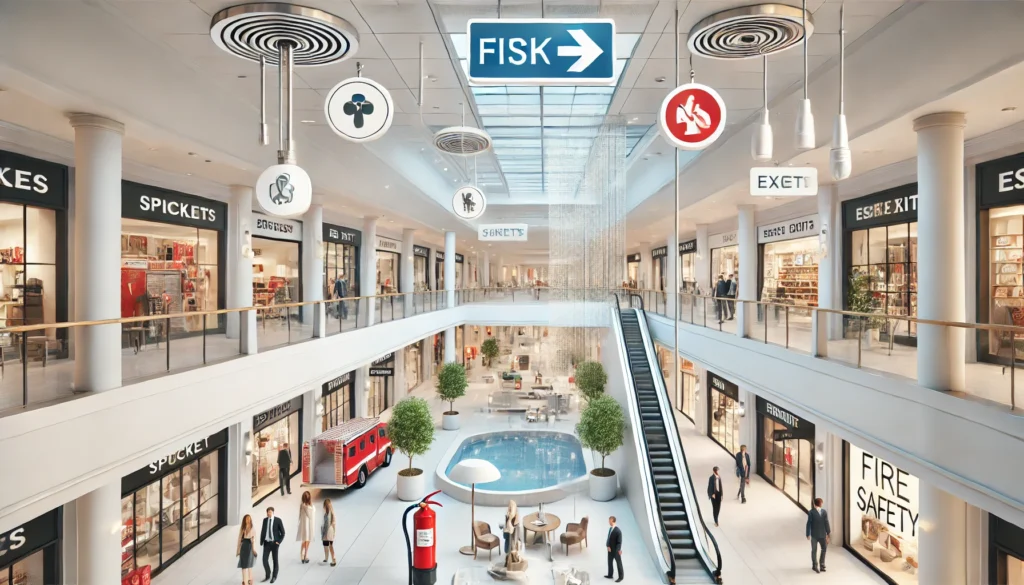Shopping malls require a proactive fire safety strategy due to high occupancy, multiple tenants, extensive electrical systems, and flammable materials. A well-structured fire prevention and response plan is essential to mitigate fire hazards, facilitate safe evacuations, and protect both property and lives. Below are the key considerations for fire safety in shopping centres.
1. Fire Risk Assessment & Prevention
- Identify fire-prone areas such as food courts, electrical rooms, storage sections, and retail spaces with flammable materials (e.g., clothing, decorations, plastic items).
- Conduct a fire load analysis to determine the necessary suppression system requirements.
- Assess evacuation pathways to eliminate bottlenecks and ensure unobstructed emergency routes.
- Implement a fire hazard reporting system to identify and resolve risks promptly.
- Regularly inspect kitchen exhaust systems in food courts to prevent grease fires.
2. Fire Detection & Alarm Systems
- Install multi-sensor smoke, heat, and flame detectors in all sections, including retail spaces, parking areas, and basements.
- Use addressable fire alarm panels to accurately locate fire incidents for quick response.
- Ensure public address (PA) systems and fire alarms are clearly audible and visible throughout the mall.
- Connect fire alarms to automated emergency notification systems for instant alerts to fire stations and security teams.
- Schedule routine testing and maintenance of fire detection systems to prevent failures.
3. Fire Suppression Systems
A. Sprinkler Systems
- Install automatic sprinkler systems in retail stores, food courts, and parking lots.
- Use Early Suppression Fast Response (ESFR) sprinklers for atriums and high-ceiling areas.
B. Water-Based Fire Suppression
- Deploy Medium Velocity Water Spray (MVWS) for general shopping areas.
- Utilize High Velocity Water Spray (HVWS) in transformer and utility rooms.
- Strategically place fire hydrants and hose reels for immediate firefighter access.
C. Specialized Fire Suppression Systems
- Gas-based suppression systems (FM-200, CO₂, Novec 1230) for server rooms and electrical infrastructure.
- Foam suppression systems in fuel storage, generator rooms, and commercial kitchens.
- Ensure fire extinguishers (ABC, CO₂, and foam types) are readily available across all mall sections.
4. Emergency Exits & Evacuation Planning
- Clearly mark and illuminate all emergency exits with backup power support.
- Design multiple evacuation routes to prevent congestion during emergencies.
- Install fire-rated doors, smoke barriers, and automatic closing stairwell doors to limit fire spread.
- Conduct fire drills for tenants, mall staff, and security teams to ensure evacuation efficiency.
- Implement wheelchair-accessible exits and emergency plans for individuals with disabilities.
5. Smoke Control & Ventilation
- Install automatic smoke exhaust systems in large open areas and atriums.
- Ensure pressurized stairwells and fire-rated corridors prevent smoke infiltration.
- Integrate HVAC systems with fire alarms to enable automatic shutdown and smoke extraction.
- Maintain CO₂ and toxic gas detectors in underground parking zones and enclosed spaces.
6. Electrical & Fire Load Management
- Utilize fire-resistant cables and circuit breakers to minimize electrical fire risks.
- Install fire-rated electrical panels in all major utility rooms.
- Conduct scheduled inspections of wiring, especially in food courts, kiosks, and holiday decoration setups.
- Use thermal imaging technology to detect overheating or faulty electrical components.
7. Firefighter Access & Emergency Readiness
- Maintain a fire command center with real-time monitoring of fire detection and suppression systems.
- Provide dedicated firefighter lifts for rapid response to upper floors.
- Mark firefighting zones with hydrants, extinguishers, and fire-resistant storage areas.
- Keep emergency response plans and fire department contact lists updated.
- Ensure clear and unobstructed access routes for fire trucks and emergency responders.
8. Fire Safety Compliance & Training
- Adhere to NFPA 101 (Life Safety Code) and local fire safety regulations.
- Train mall personnel, security staff, and tenants on fire prevention measures, evacuation protocols, and extinguisher use.
- Display fire safety signage and emergency instructions in multiple languages.
- Schedule annual fire audits to evaluate fire preparedness and system functionality.
9. Routine Fire Safety Inspections & Maintenance Checklist
| Inspection Task | Frequency |
| Check fire alarm and detection systems. | Monthly |
| Test public address and emergency announcement systems. | Monthly |
| Verify sprinkler system operation and water supply. | Quarterly |
| Inspect fire hydrants, hose reels, and extinguishers. | Quarterly |
| Ensure emergency exit signage and lighting are functional. | Quarterly |
| Conduct smoke control and ventilation system performance tests. | Semi-Annually |
| Train staff and tenants on fire safety and evacuation drills. | Semi-Annually |
| Inspect electrical panels and fire-resistant wiring installations. | Annually |
| Audit firefighter access routes and emergency response efficiency. | Annually |
